| Music | Literature | Film | Index | About |

|
The Library of Congress Recordings, Lead Belly Library of Congress (rereleased by Rounder Records 1991-1995), done by John and Alan Lomax 1934 to 1943 Track Listing: Midnight Special, Vol. 1: 1. Irene (Goodnight Irene), 2. Irene (Goodnight Irene), 3. Matchbox Blues, 4. Midnight Special, 5. Governor O.K. Allen, 6. Frankie and Albert, 7. Ella Speed, 8. Red River, 9. Get Up in the Mornin’, 10. You Don’t Know My Mind, 11. I’m Sorry Mama, 12. Take a Whiff on Me, 13. DeKalb Blues, 14. Roberta, 15. Careless Love. Gwine Dig a Hole to Put the Devil In, Vol. 2: 1. C.C. Rider, 2. Governor Pat Neff, 3. Becky Dean, 4. Medicine Man, 5. Alberta, 6. Old Rattler, 7. If It Wasn’t for Dicky, 8. Queen Mary, 9. Turn Yo’ Radio On, 10. Mama, Did You Bring Any Silver?, 11. The Bourgeois Blues, 12. Po’ Howard, 13. Dance Calls (Includes "One Dollar Bill, Baby"), 14. Gwine Dig a Hole to Put the Devil In, 15. Green Corn. Let It Shine on Me, Vol. 3: 1. Monologue on the Mourner’s Bench, 2. You Must Have That Religion, Halleloo, 3. Backslider, Fare Thee Well, 4. Monologue on Square Dances or Sookey Jumps, 5. Down in the Valley to Pray, 6. Let It Shine on Me, 7. Run Sinners, 8. Ride On, 9. Howard Hughes, 10. When I Was a Cowboy, 11. Leaving Blues, 12. The Roosevelt Song, 13. The Scottsboro Boys, 14. No Good Rider, 15. Blues About New York, 16. Mr. Hitler. The Titanic, Vol. 4: 1. Blind Lemon Blues, 2. Mister Tom Hughes’ Town, 3. Shreveport Jail, 4. Don’t You Love Me No More, 5. Henry Ford Blues, 6. Julie Ann Johnson, 7. Angola Blues (So Doggone Soon), 8. Dallas and Fort Worth Blues, 9. Mary Don’t You Weep, 10. Easy Mr. Tom, 11. I Ain’t Bothered a Bit, 12. Boll Weevil, 13. The Titanic, 14. Red Cross Sto’, 15. Fo’ Day Worry Blues, 16. Hesitation Blues, 17. Take Me Back, 18. Tight Like That, 19. Sail on Little Girl. Nobody Knows the Trouble I’ve Seen, Vol. 5: 1. Ho Day, 2. One Dollar Bill, Baby, 3. Ain’t Goin’ Down to the Well No More, 4. Shorty George, 5. Ha-Ha Thisaway, 6. Where de Sun Gone Down, 7. Bring Me Water Silvy, 8. Monkey Man, 9. Ain’t Gonna Ring Dem Yallow Woman’s Do’ Bells, 10. Rock Island Line, 11. Billy the Weaver, 12. Ain’t Gonna Drink No More, 13. New York City, 14. The Hindenburg Disaster, Pt. 1, 15. The Hindenburg Disaster, Pt. 2, 16. Git on Board, 17. Outshine the Sun, 18. Nobody Knows the Trouble I’ve Seen, 19. Little John Henry. Go Down Old Hannah, Vol. 6: 1. T.B. Blues, 2. How Long?, 3. When the Train Comes Along, 4. Monologue on Square Dances or Sookey Jumps, 5. Monologue on the Blues, 6. Amazing Grace, 7. Old Time Religion, 8. Stand Your Test in Judgement, 9. Christmas (Monologue), 10. John Henry, 11. John Hardy, 12. Go Down Old Hannah, 13. Oh, Something on My Mind, 14. How Long?, 15. Swing Low Sweet Chariot, 16. Ain’t Gonna Study War No More, 17. Join the Band, 18. Prayer.
That the artists listed span genres far and wide is a telling tale in and of itself lending insight into the difficulty in neatly categorizing Lead Belly’s vast musical résumé and prowess. He was more than a folk musician. More than a deep south country bluesman. More than a gospel crooner. He was a sponge who absorbed the sounds of musicians that he came across and was likewise influenced by, including the great Father of the Texas Blues, Blind Lemon Jefferson, Woody Guthrie, and numerous unknowns that he heard while in prison or while traveling with legendary music archivists, John and Alan Lomax. So what is it that attracted such a diverse group of later day musicians to the recordings of Lead Belly? A logical place to start is his singing. Boy, could he belt a tune. Lead Belly possessed a singular voice and vocal style that projects an enormity of raw emotion within its powerful boom. It’s almost as if Lead Belly was acutely aware of the role his recordings might one day play in chronicling a painful and dubious time and place in American history. His voice captures an intensity of feeling that connects the listener deeper into the core of embedded messages that lyrics alone or the stories they tell can only hope to scratch the surface of. Equally as alluring was his masterful manipulation of the guitar. He could play the shit out any guitar, be it the 6-string or the complex 12-string he is most identified with. If ever there was a picker and strummer that could tell a tale within the frets, Lead Belly was it. That his singing could not only keep up but match the earnestness of his playing was certainly gravy. Tales of woe, prison life, booze, angst, racism, injustice, jealousy, women, the everyday toil of a hard life, you name it, Lead Belly expressed all with an exuberance and glee that make even the most sorrowful blues come across with a jubilance that is a signature of great music. When you can hear the joy in the delivery, the music shines. Whatever that certain magic is that makes an artist more than simply technically good but also transcendent, Lead Belly had it. Simply put, Lead Belly was born to deliver the goods. There can be no doubt that had it not been for Lead Belly, the rich landscape of artists and sounds that followed in his wake would have been forever altered. Consider any of the artists you are listening to currently through those earbuds or slick bookshelf speakers of yours. It is a good bet that it wouldn’t take six degrees of separation to trace influence back to one hell of a badass and his trusted guitar.
|
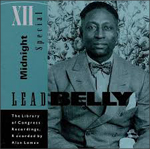 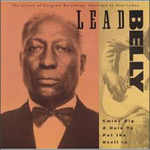 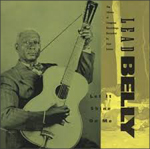 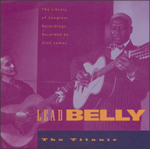 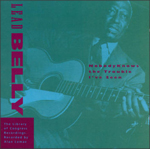 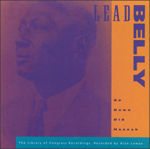
|
||||||